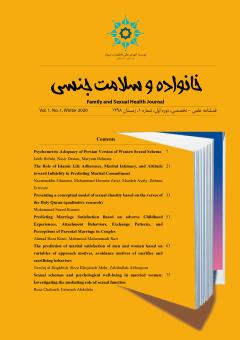Sexual schemas and psychological well-being in married women: Investigating the mediating role of sexual function
Subject Areas : GeneralReza Chalme 1 , Fateme Abdollahi 2
1 -
2 - 2. دانشجوی کارشناسی ارشد روانشناسی عمومی، موسسه آموزش عالی فاطمیه شیراز
Keywords: sexual schemas, psychological well-being, sexual function, married women.,
Abstract :
The aim of this study was to investigate the mediating role of sexual function in the relationship between sexual schemas and psychological well-being in married women. The descriptive research method was a constraint type which was performed using structural equation modelling method. The statistical population included married women from Shiraz. Using the available sampling method, 150 people were selected. Assessment tools included women's sexual performance index questionnaires (Rosen et al., 2000), sexual schema (Anderson and Sirvanowski, 1994), and psychological well-being (Reef, 1995). The data collected were analyzed in two descriptive levels (using mean, standard deviation) and inferential (using correlation coefficient and structural equation modelling with amos-21 software). The results showed that passionate-romantic and explicit-comfortable schemas had a positive and significant relationship and shy-cautious schemas had a negative and significant relationship with psychological well-being in married women. Sexual function was also a positive and significant predictor of psychological well-being. In addition, the results indicated that sexual function was able to mediate between passionate and romantic schemas and psychological well-being. Based on the research findings, it can be concluded that sexual schemas both directly and through sexual function can affect the psychological well-being of married women.


